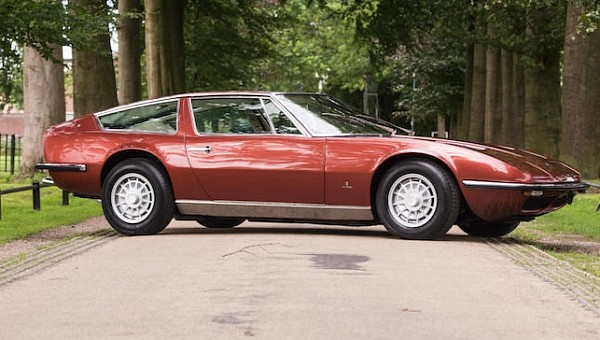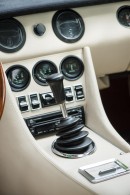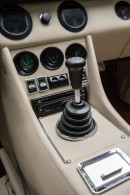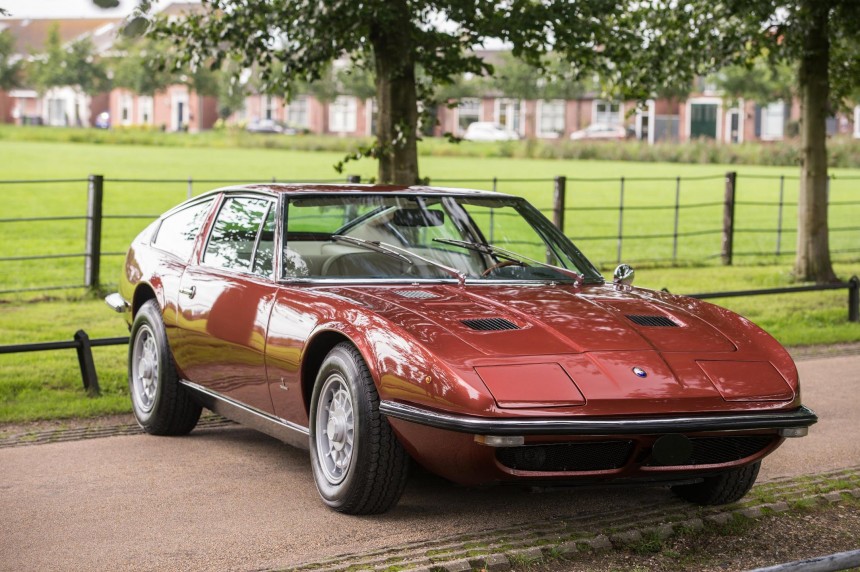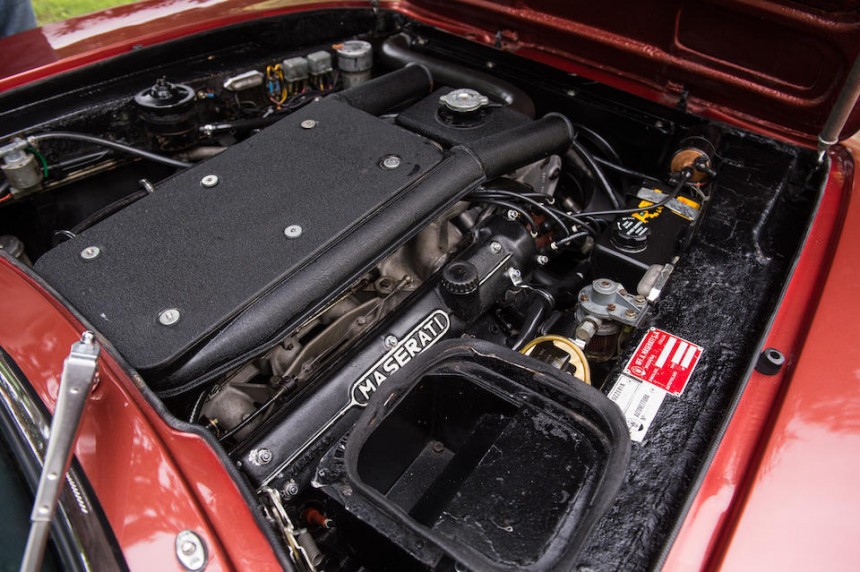The Maserati brothers decided to sell their shares in the company in 1937, with a gentleman by the name of Adolfo Orsi taking control of the Bologna-based automaker that would be relocated to Modena. Financial struggles forced the Orsi family to give up Maserati in 1968 to Citroen, which finalized the design of the Vignale-bodied GT known as the Indy.
First things first, why didn’t they call it something more exotic? Maserati looked back at its on-track exploits for the Indy’s name, specifically at its back-to-back victories at the Indianapolis 500. The 8CTF, which packs a straight-8 powerplant capable of producing in excess of 350 horsepower from a displacement of 3.0 liters, won the 1939 and 1940 editions with Indiana-born racing driver Wilbur Shaw behind the wheel of chassis 3032.
Met with highly positive critical reception at the 1968 Salone dell'Automobile di Torino, the Indy replaced two models: the Vignale-bodied Sebring and Frua-bodied Quattroporte. Shorter in both overall length and wheelbase than the Mexico, the Indy was designed to be that little bit chicer than the conservative yet incredibly elegant Mexico. Previously covered on autoevolution, the Mexico can trace its roots back to 5000 GT chassis 103.022 that Mexican president Adolfo Lopez Mateos had owned.
Offered exclusively as a fixed-head coupe with 4+4 seating, the Indy was updated to series-production specification in time for the 1969 Geneva Motor Show. Based on the Mexico’s chassis, albeit modified for this application, the gran turismo measures 2,600 millimeters between its front and rear axles as opposed to 2,640 millimeters for the Mexico. Rather than a straight-8 as the “Boyle Special” 8CTF that won the Indy 500, the Indy flaunts a dual-overhead-camshaft V8 with an alloy block and alloy heads.
From 1969 through 1975, the House of the Trident rolled out no fewer than three V8s for the Indy. 1975 also marks a rather sad event in Maserati's history. Citroen spent a lot of money on very weird projects during that era, including a rotary-engined coupe based on the Ami. These totally unnecessary expenses, in combination with the oil crisis of 1973, forced the French automaker to sell off the Italian automaker. The Ministry of Industry and Alejandro de Tomaso gained control of the company in August 1975.
Fitted as standard with servo-assisted brakes, the Indy originally came with a 4.2-liter V8 shared with the Quattroporte. Fed by twin fuel tanks and four carburetors from Weber compared to three for the Mexico, the AM 107 engine runs an 8.5:1 compression ratio and electronic ignition.
Connected to a five-speed manual transmission supplied by ZF and a Salisbury rear differential, the 4.2L Indy cranks out 256 horsepower (260 ps) at 5,500 revolutions per minute and 275 pound-foot (373 Nm) at 3,800 rpm.
Ventilated rotors also need to be mentioned, along with an optional three-speed automatic supplied by BorgWarner. 14-inch alloys from Borrani and four-bolt wheel hubs were standard issue. Measuring 7.5 inches in width, these alloys could be specified with rubber from Pirelli or Michelin. Maserati launched a more powerful Indy at the 1970 Turin Motor Show in the guise of a 4.7-liter V8 codenamed AM 107/1 by the Modenese outfit.
Bore increased from 88 to 93.9 millimeters, resulting in a well-deserved performance bump to 286 ponies (290 ps) at 5,500 rpm and 275 lb-ft (373 Nm) at 3,800 rpm. Capable of 260 kilometers per hour (nearly 162 miles per hour) compared to 250 kph (155 mph) for the lesser sibling, the 4.7L Indy also introduced a few interior design changes. The twin binnacle design of the 4.2L Indy was replaced by a more conventional but slightly better integrated layout comprising a small driver-side cowl and five additional gauges.
The instrument cluster houses the utmost essential instruments produced by Veglia Borletti. Black vinyl was used for the top of the dashboard, whereas the dashboard fascia was trimmed in the same leather upholstery as the transmission tunnel and seats. Other production changes introduced by the 4.7L Indy include air conditioning and power steering as standard.
A few months after the 1970 Turin Motor Show, the Italian manufacturer introduced the Indy America specifically for the U.S. market. Come 1973, the peeps in Modena dropped both the 4.2- and 4.7-liter V8 engines in favor of a 4.9-liter V8 that is almost similar to the powerplant in the Ghibli SS.
The AM 107/49 in the Indy uses wet-sump lubrication rather than the dry-sump oiling system of the Ghibli SS. The 4,930-cc mill produces 315 horsepower (319 ps) at 5,500 revolutions per minute and 355 pound-foot (481 Nm) of torque at 4,000 revolutions per minute, which enables this variant of the Indy to reach 265 kilometers per hour (165 miles per hour) at full chatter.
Not a light car, with the lightest specification tipping the scales at 1,680 kilograms (3,704 pounds) with all fluids accounted for, the Indy came standard with tinted windows, a rather beautiful clock, electric windows, integrated headrests, and an adjustable steering column. The rear seats are wide enough and provide enough legroom even for adults on short trips.
The 4.9-liter update further improved the breed with a Citroen-sourced braking system, and Maserati also upsized the wheels to 15 inches. 4.9 models further benefit from a few changes to the instrumentation, as well as three instead of two hood vents. The final iteration of the Indy also boasts a different tranny, namely the Khamsin’s manual with a dog-leg reverse.
Replaced by the Kyalami, which is twinned with the De Tomaso Longchamp due to Alejandro De Tomaso’s way of doing business at Maserati, the Indy was retired in 1975 with a little over 1,100 units to its name. 1,104 units, to be more precise, of which the Indy 4200 is the most common (make that 440 examples), whereas the Indy 4900 is the rarest of the lot (300 examples).
Met with highly positive critical reception at the 1968 Salone dell'Automobile di Torino, the Indy replaced two models: the Vignale-bodied Sebring and Frua-bodied Quattroporte. Shorter in both overall length and wheelbase than the Mexico, the Indy was designed to be that little bit chicer than the conservative yet incredibly elegant Mexico. Previously covered on autoevolution, the Mexico can trace its roots back to 5000 GT chassis 103.022 that Mexican president Adolfo Lopez Mateos had owned.
Offered exclusively as a fixed-head coupe with 4+4 seating, the Indy was updated to series-production specification in time for the 1969 Geneva Motor Show. Based on the Mexico’s chassis, albeit modified for this application, the gran turismo measures 2,600 millimeters between its front and rear axles as opposed to 2,640 millimeters for the Mexico. Rather than a straight-8 as the “Boyle Special” 8CTF that won the Indy 500, the Indy flaunts a dual-overhead-camshaft V8 with an alloy block and alloy heads.
From 1969 through 1975, the House of the Trident rolled out no fewer than three V8s for the Indy. 1975 also marks a rather sad event in Maserati's history. Citroen spent a lot of money on very weird projects during that era, including a rotary-engined coupe based on the Ami. These totally unnecessary expenses, in combination with the oil crisis of 1973, forced the French automaker to sell off the Italian automaker. The Ministry of Industry and Alejandro de Tomaso gained control of the company in August 1975.
Connected to a five-speed manual transmission supplied by ZF and a Salisbury rear differential, the 4.2L Indy cranks out 256 horsepower (260 ps) at 5,500 revolutions per minute and 275 pound-foot (373 Nm) at 3,800 rpm.
Ventilated rotors also need to be mentioned, along with an optional three-speed automatic supplied by BorgWarner. 14-inch alloys from Borrani and four-bolt wheel hubs were standard issue. Measuring 7.5 inches in width, these alloys could be specified with rubber from Pirelli or Michelin. Maserati launched a more powerful Indy at the 1970 Turin Motor Show in the guise of a 4.7-liter V8 codenamed AM 107/1 by the Modenese outfit.
Bore increased from 88 to 93.9 millimeters, resulting in a well-deserved performance bump to 286 ponies (290 ps) at 5,500 rpm and 275 lb-ft (373 Nm) at 3,800 rpm. Capable of 260 kilometers per hour (nearly 162 miles per hour) compared to 250 kph (155 mph) for the lesser sibling, the 4.7L Indy also introduced a few interior design changes. The twin binnacle design of the 4.2L Indy was replaced by a more conventional but slightly better integrated layout comprising a small driver-side cowl and five additional gauges.
The instrument cluster houses the utmost essential instruments produced by Veglia Borletti. Black vinyl was used for the top of the dashboard, whereas the dashboard fascia was trimmed in the same leather upholstery as the transmission tunnel and seats. Other production changes introduced by the 4.7L Indy include air conditioning and power steering as standard.
A few months after the 1970 Turin Motor Show, the Italian manufacturer introduced the Indy America specifically for the U.S. market. Come 1973, the peeps in Modena dropped both the 4.2- and 4.7-liter V8 engines in favor of a 4.9-liter V8 that is almost similar to the powerplant in the Ghibli SS.
Not a light car, with the lightest specification tipping the scales at 1,680 kilograms (3,704 pounds) with all fluids accounted for, the Indy came standard with tinted windows, a rather beautiful clock, electric windows, integrated headrests, and an adjustable steering column. The rear seats are wide enough and provide enough legroom even for adults on short trips.
The 4.9-liter update further improved the breed with a Citroen-sourced braking system, and Maserati also upsized the wheels to 15 inches. 4.9 models further benefit from a few changes to the instrumentation, as well as three instead of two hood vents. The final iteration of the Indy also boasts a different tranny, namely the Khamsin’s manual with a dog-leg reverse.
Replaced by the Kyalami, which is twinned with the De Tomaso Longchamp due to Alejandro De Tomaso’s way of doing business at Maserati, the Indy was retired in 1975 with a little over 1,100 units to its name. 1,104 units, to be more precise, of which the Indy 4200 is the most common (make that 440 examples), whereas the Indy 4900 is the rarest of the lot (300 examples).
